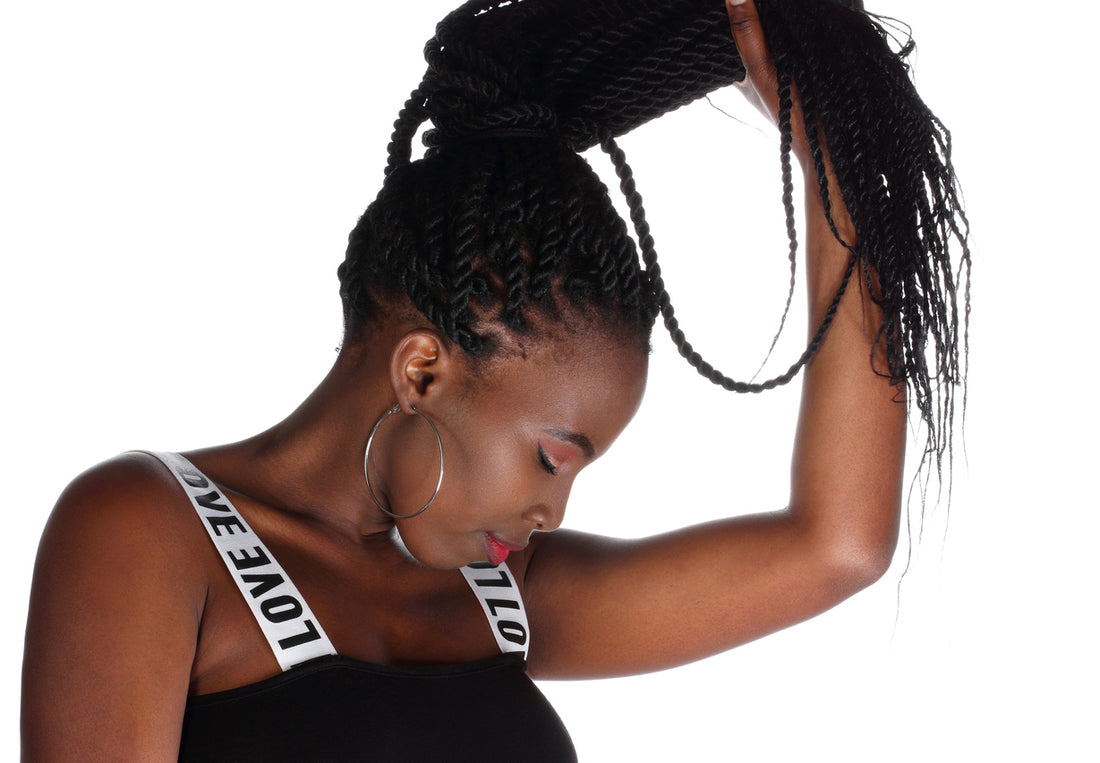
Preparing Your Hair For a Protective Style

There's a chill in the air and a hint of autumn in the trees. Cozy sweaters abound, pumpkin spice everything is becoming our new favorite aesthetic, and we're beginning to settle into the most wonderful time of the year -- for everyone but curly-haired ladies. Winter weather can be the enemy of healthy hair. Dry air, harsh winds, snow, and rain all wreak havoc on our beautiful natural hair, causing breakage and frizz. The end result isn't exactly holiday card-worthy. In fact, winter is often the most challenging time of the year when it comes to caring for curly hair. Type 3 and Type 4 curly hair is especially prone to damage due to harsh environmental factors that commonly occur around what should be a time for joy and good tidings. While many covet curly hair for the perfect fall photoshoot, caring for natural hair takes time and dedication. That's why many curly-haired fall fashionistas opt for a protective style to keep their curls luscious and radiant all season long. There's no need to untag yourself from photos when your style is always on the nice list.
A protective style is a secret behind perfection. If you've spied amazing natural hairstyles for the winter months on your Instagram, chances are these dynamic looks were the product of a fabulous faux hairstyle and tons of nourishment and TLC for the natural hair beneath. Take a look at our best beauty secrets for preparing natural hair for a protective style.
Harness the Power of Protective Style
The winter blues are a real threat to your curls. Wind, cold weather, and dry air strip away moisture, which causes the strands to become brittle and prone to breakage. This is why our natural hair sometimes loses its fullness and elasticity in the winter months, especially if you've opted for a daily shampoo routine in previous years.
Healthy hair is supported by a balance of washing and protecting. Knowing which seasons are best for which healthy hair regimen is key for maintaining flawless natural hair. In the fall and winter months, protective styles are the best way to minimize damage by protecting your ends from the elements. Protective styles also minimize washing and touching the natural hair, which may already be weakened from dryness. If you're growing your hair out, a protective style is a must.
Don't limit yourself to simple box braids every autumn. Mix it up by trying creative new styles like Fulani braids and beads, faux locks, and so much more. If you're really feeling adventurous, now is a great time to add a pop of color without compromising your natural hair in the process.
Don't Rely on Protective Styles Alone
While protective styles are a great solution to the winter blues, it's important not to rely too heavily on your brand new faux hair. Protective styles are not the kind of hair that you can simply forget about once you leave the salon. Taking care of your natural hair and developing a good healthy hair routine is key.
While you can generally expect a lighter care routine for protective styles, it's important to apply a light moisturizer to your roots and a lightweight oil such as coconut or argan oil every couple of days. Listen to your hair and watch for signs of damage. As a good rule of thumb, it's best to redo your style every two weeks to optimize healthy hair.
Maximize Moisture
Moisturizing your hair is critical when prepping your natural hair for a protective style. If you're looking for a budget-friendly, DIY moisturizer for natural hair, try a simple recipe of water, aloe vera juice, glycerin, coconut oil, olive oil, and essential oil in a spritz bottle for a quick morning and evening refresh.
Never leave the house with wet hair. Do use steam as a hair treatment to penetrate and hydrate your curls. Ditch the shower cap in the winter months and embrace a lovely sauna experience for your hair.
Trim and Sculpt
This step is especially important for anyone growing out natural hair. Healthy hair requires upkeep as your curls continue to grow. While a protective style shields your ends from damage, you'll still need to check each strand for signs of splitting and trim split ends as you find them. A good time to do this is right before your next salon appointment as the perfect prep for switching out styles.
Nourish
Just as we double up on healthy vitamins to protect our immune systems in the colder months, healthy hair also requires extra nourishment. Prioritize health and wellness for your hair, skin, and nails alongside the rest of your winter wellness routine. Vitamin D is essential for healthy hair. and is most often lacking during the winter months due to low sunlight. Try to increase your Vitamin D intake with fortified, nutrient-dense foods like fish, nuts, and avocado.
Vitamins A and C, often found in berries, sweet potatoes, bananas, spinach, and other whole foods, are also fantastic supplements for healthy hair. The full spectrum of B vitamins, as well as iron to promote oxygenation of cells that strengthen hair, skin, and nails, should be in your winter wellness pantry.
Of course, all of us go through weeks where we eat more Christmas cookies than blueberry smoothies. Support your self-care -- and indulgence -- with high-quality supplements for healthy hair.
Avoid Knitwear
Knitted hats and scarves may look like the perfect accessory for cozy autumn, but beauties beware when it comes to rough material. These cozies will snag on your natural hair and cause frizz and breakage. To protect your hair while protecting your ears from the cold, wear a thin silk cap beneath your knitwear or opt for light cotton apparel instead.
Synthetic, moisture-wicking headbands, beanies, and scarves designed for athletic wear are also a great alternative for sporty fashionistas on the go, as well as a simple pair of wrap-around ear muffs.
Minimize Heat Damage
Cozying up by the fireside is all well and good, but avoiding heat is one of the best ways to prepare your natural hair for a protective style. Don't worry; you can still enjoy those autumn bonfires. Stay away from heat styling with flat irons and curling irons. If you're in between styles and waiting to enjoy your fabulous new look, style your hair with clips, breakage protecting hair ties instead of elastics, and get creative with different braids, updos, buns, and ponytails.
Drying your hair in the winter may sound tempting, but the added heat causes brittleness that results in frizz, lackluster color, and overall poor hair health. Add a Reverse Air hair dryer to your winter beauty arsenal instead! Many curly-haired ladies are surprised to discover that a reverse air hair dryer is actually quicker and more efficient than a traditional hairdryer -- all without frying your lovely locks.
A Winter Masquerade
You can never deep condition too much when it comes to protecting your natural hair. Set aside a few nights a week for a nourishing hair mask, kick your feet up, and enjoy a comfortable night in as you take a break from the hustle and bustle of parties and gatherings. Steer clear of the generic conditioners and masks you might spot while gift shopping. Many of these contain harsh chemicals and additives that actually strip away color and moisture.
Instead, opt for sulfate-free and paraben-free beauty products designed with curly hair in mind. No extra dyes, fragrances, or thickeners are necessary to achieve healthy hair. Voluminous curls are best supported by a regimen of delicate care. Remember; simplicity is the most beautiful quality of all, especially when it comes to maintaining natural hair during the winter months.
Include an anti-humectant (a healthy hair-approved oil or butter) to seal in moisture. This will create a shield around your natural hair and protect your delicate strands from harsh air, wind, and cold. Olive oil or jojoba oil are fabulous natural anti-humectants that work well for preparing natural hair for a protective style. Whichever oil you choose, make sure your formula is liquid at room temperature, non-sticky, and won't weigh your hair down.
There's nothing quite as picturesque as flawless curls in autumn weather. With the leaves beginning to change, it's time for a style refresh. The best time to prepare your natural hair for a protective style is in the weeks leading up to your salon appointment. Get started by creating your own natural hair routine for cold weather with our go-to tips for healthy hair any time of the year.
Need more healthy hair inspiration? Reach out to our RevAir Advisors for insight tailored to your unique hair type and keep on stunning with your radiant natural locks.















